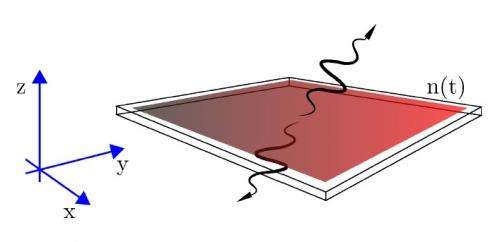When a laser pulse illuminates a thin film of material, such as graphene, the medium (thin film) oscillates. This oscillation is analogous to a periodic spacetime expansion-contraction or gravitational wave. The gravitational wave is predicted to emit photons, which can be detected to signify the presence of the gravitational wave. N. Westerberg, et al. ©2014 IOP Publishing Ltd
(Phys.org) —Although the curves and ripples of spacetime are suspected to be full of intriguing secrets about the history of the universe, they are also extremely difficult to study. For this reason, some physicists are turning to the lab to attempt to recreate spacetime geometries where they can be more easily analyzed.
In a new paper published in the New Journal of Physics, Niclas Westerberg, et al., from institutions in the UK and Italy have proposed a new way to construct artificial spacetime in the lab.
By illuminating a very thin film (such as graphene) with an ultrashort and intense laser pulse, the scientists show that it may be possible to model the periodic expansion and contraction of cosmological spacetime. They explain that this type of medium can be likened to a gravitational wave, a ripple in the fabric of spacetime. Further, the scientists predict through calculations that these gravitational waves may amplify electromagnetic radiation, producing large numbers of photons that can potentially be detected.
"Given the correct boundary conditions, gravitational waves can give rise to the emission of photons," Daniele Faccio, Professor at Heriot-Watt University in Edinburgh, UK, told Phys.org. "These can then be used to detect the waves themselves."
Faccio emphasized that the main result of the paper refers to the study of an artificial system, so these gravitational waves in the artificial system are not real. However, he explained that the artificial system could lead to a method for detecting real gravitational waves:
"On the basis of our artificial system, we do then propose a system that could measure real gravitational waves. This is a long superconducting wire that can be excited by a real gravitational wave and will emit radio waves in the kHz region that can then be detected at the wire extremities. This system could, in principle, be an alternative route to detecting gravitational waves and would rely on a fundamentally very different mechanism to that proposed so far in all other detection systems (based, for example, on fluctuating masses)."
As the physicists explain, the new system is a form of parametric amplification, where a laser emits light of variable wavelengths. However, traditional parametric amplification usually consists of a medium, such as a crystal, that is many wavelengths longer than the wavelength of the incoming light. As a result, the oscillation occurs inside the medium, while the medium itself does not oscillate.
In contrast, the medium in the proposed model has a subwavelength thickness so that the medium itself does oscillate. The scientists note that both forms of parametric amplification are examples of the dynamic Casimir effect, in which photons are produced due to an accelerated or suddenly changing medium.
If constructed, the proposed system would provide a platform for researchers to study the cosmological expansion and contraction of spacetime, as well as how photons may be excited due to the ripple-like gravitational waves of spacetime. This analysis could also offer a glimpse into a broader family of quantum field effects in curved spacetimes.
"We definitely have plans for building the artificial system, for example, the graphene film excited by a periodic wave train that mimics the gravitational wave," Faccio said. "Regarding the superconducting wire idea, this would first of all require a deeper study to evaluate all potential difficulties and pitfalls."
More information:
N. Westerberg, et al. "Experimental quantum cosmology in time-dependent optical media." New Journal of Physics. DOI: 10.1088/1367-2630/16/7/075003
Also at arXiv:1403.5910 [gr-qc]
Journal information: New Journal of Physics
© 2014 Phys.org
























